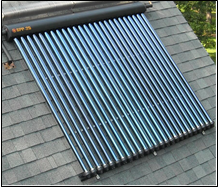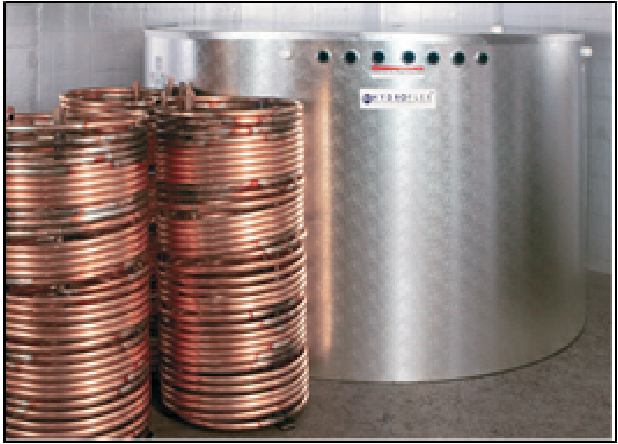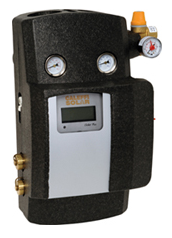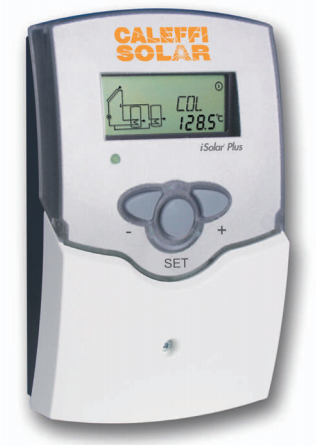Solar space heating systems are an effective and excellent way to reduce costly energy bills during your heating season.
A solar space heater works alongside your current heating system to use the sun's energy to reduce your consumption of oil, propane, or other fossil fuels.
Traditionally used with solar evacuated tube collectors, these systems work to provide free, solar heating for your home throughout your entire heating system. These solar heating systems can also be combined with our solar-ready ultra high efficiency DC-Inverter heat pump chiller.
The average American family spends over $2,000 a year in heating costs. Heating systems that rely on fossil fuels, such as oil, propane, and natural gas will continue to rise in cost.
By using a solar space heating system, you can take advantage of the sun's free, abundant energy to heat your home for free. Heating your home with a solar heating system can significantly reduce your winter fuel bills. Another excellent benefit is that a solar space heating system also heats domestic hot water.
A solar space heating system will also reduce the amount of air pollution and greenhouse gases that result from your use of fossil fuels such as oil, propane, and other petroleum products.
Since our collectors are rated, tested, and certified by the SRCC, your solar space heating system also qualfies for various rebates and financial incentives, such as the Federal 30% tax credit. For a full listing of incentives in your area, please visit www.dsireusa.org, or contact us today.
 (1) A solar space heating system works with your existing hydronic (hot water) based heating system. The solar collectors circulate a fluid, usually a corn glycol through the solar array, where it is heated, and then transferred back to the solar storage tank.
(1) A solar space heating system works with your existing hydronic (hot water) based heating system. The solar collectors circulate a fluid, usually a corn glycol through the solar array, where it is heated, and then transferred back to the solar storage tank.
(2) As the heated fluid is circulated through the storage tank, the storage tank's water is heated. The temperatures in the tank can reach anywhere from 130F to 175F.
(3) The hot water that is used by your existing heating system - such as in a radiant floor system - is circulated through a heat exchanger in the storage tank.
As the water passes through the heat exchanger, it is warmed, and then returned to your heating system.
This effectively keeps your heating system off - or significantly shortens the amount it runs. Your home is now being warmed by free energy provided by the sun.
(4) An added heat exchanger is often used with solar space heating systems to provide for domestic hot water as well. This is especially effective during the summer months, when the heating system is not active.
This is just one example of a solar space heating system. These systems are often designed to fit your specific application and home, and can be used to provide heat for other systems, such as for a pool.
For larger, commercial, space heating or air conditioning systems, please visit our Commercial section.
Solar space heating systems can be applied to a number of different home heating systems, and are an effective way to significantly reduce your monthly energy costs.
Below are some of the most popular applications for using solar energy to heat one's home.
 Because a radiant floor uses low to medium temperature water to heat a space directly, it is one of the simplest and cost effective systems to use in conjunction with a solar space heating system.
Because a radiant floor uses low to medium temperature water to heat a space directly, it is one of the simplest and cost effective systems to use in conjunction with a solar space heating system.
Most radiant floor systems use water ranging from 90F to 120F as a heat source, circulating this water through your floors. A solar heating system easily provides water temperatures in excess of 140F, making this an ideal solution.
A solar water heating system can be sized to provide a small supplement to your heating system, lowering your costs by 20% to 30%, or be sized much larger, to cut as much as 80% of your home heating bills. Each system can be scaled to your needs, goals, and budget. For radiant heating (floor heating) buffer tanks click here.
 Using a solar water heating system in conjunction with low temperature baseboards can also be an effective solution to rising energy costs.
Using a solar water heating system in conjunction with low temperature baseboards can also be an effective solution to rising energy costs.
Most low temperature baseboards require water between 120F and 140F, which a solar heating system can easily supply. Usually, in these types of applications, the solar heating system is designed to supply the homes heat during the day, cutting energy costs by 50% or more.
 A solar heating system can be used in conjunction with a FHA (Forced Hot Air) system as well. Usually, most FHA systems do not use hot water to heat the home. Instead, they heat the air with electric heaters, propane, or some other fuel.
A solar heating system can be used in conjunction with a FHA (Forced Hot Air) system as well. Usually, most FHA systems do not use hot water to heat the home. Instead, they heat the air with electric heaters, propane, or some other fuel.
A solar water heating system can be used by having a licensed HVAC company outfit your duct work with hot water coils. This will enable the water heated by the sun's energy to circulate through your duct work, and only the fan of the FHA system needs to run. This can significantly reduce your monthly energy costs, and keep from burning propane, or other fuels to warm your home.
For more information on a solar space heating system, please contact us.
Solar Panels Plus offers complete solar space heating systems for homes all over the USA. These solar heating systems have been engineered and packaged to seamlessly integrate into your home's existing space heating system, and include all the major components needed to generate your own free solar space heat.
These packages include the following components:
 The solar evacuated tube collector is the primary component in your home solar space heating system. The evacuated tube collectors are almost exclusively used in solar space heating systems because of their high performance and efficiency in cold and cloudy climates.
The solar evacuated tube collector is the primary component in your home solar space heating system. The evacuated tube collectors are almost exclusively used in solar space heating systems because of their high performance and efficiency in cold and cloudy climates.
The SPP-30A collectors also comply with the Buy American Act, allowing your investment to benefit domestic manufacturing.
These solar collectors are also SRCC certified and tested. This certification allows you to receive financial incentives that may be available in your state or locality, such as cash rebates, grants, tax breaks, and more. For a full listing of the incentives available in your area, please visit www.dsireusa.org.
Most solar space heat systems will include 2-5 collectors, depending on the size and demand of your home's heating needs. Each system can be tailored to fit your specific application and location, as well as your goals and budget.
More information on our solar evacuated tube collectors.
 The solar storage tank is another critical component to every solar space heating system. The solar storage tank stores heat collected from the evacuated tube collectors for use whenever it may be needed.
The solar storage tank is another critical component to every solar space heating system. The solar storage tank stores heat collected from the evacuated tube collectors for use whenever it may be needed.
The solar tank is sized to match the number of collectors as well as the demand for heat in the house. A tank that is too small will not have enough thermal storage, and a tank that is too large will not be able to effectively heat a home, and can be cost prohibitive.
Therefore, we have uniquely sized the solar storage tank to provide just the right amount of heat for your home.
These tanks will range in size, and are generally sized to fit the space you have available, your goals, and your budget. They are durable, long lasting, come backed with a full 10-year warranty, and are American made.
More information on our solar storage tanks.
 The solar pump is another important component in your home solar space heating system. The solar pump circulates fluid through your solar collectors and solar tank. We have carefully tested and selected pumps and pump stations that are able to accommodate all types and sizes of solar space heating systems. These solar pump stations are designed for easy installation, longer lifespan, durable materials, and high performance.
The solar pump is another important component in your home solar space heating system. The solar pump circulates fluid through your solar collectors and solar tank. We have carefully tested and selected pumps and pump stations that are able to accommodate all types and sizes of solar space heating systems. These solar pump stations are designed for easy installation, longer lifespan, durable materials, and high performance.
The solar pump station has a number of other essential components that are important to the installation and operation of the solar space heating system. For example, pressure and temperature gauges are include("quickly check the pressure and temperature of the solar loop. Other items such as flush and fill valves are critical to the activation of your solar hot water system.
All of the solar pumps in this package work directly in conjunction with the solar controller. The speed of the pump and the time of it's activation and deactivation is always controlled by the solar controller. The solar controller works directly with the solar pump, and also monitors and adjusts the pump to give you the best performance.
More information regarding our solar pumps and solar pump stations.
 Having well designed solar controls is critical for a well functioning solar space heating systems. Our line of solar controls have been carefully tested and selected to give the best performance in a solar space heating system.
Having well designed solar controls is critical for a well functioning solar space heating systems. Our line of solar controls have been carefully tested and selected to give the best performance in a solar space heating system.
These controllers allow for maintenance free operation of the solar space heating system. They also allow you to easily monitor and record exactly how your solar heating system is performing, with an easy interface and user friendly controls.
Various add-ons are also available for the iSolar series of solar controls, allowing for remote data monitoring, data logging, and much more.
More information on our iSolar series and solar controllers.
There are a number of other components that are needed to install a solar space heating system. Solar Panels Plus has carefully engineered prepackaged systems, so that a solar installer can quickly and professionally install your solar hot water system - without having to search for these components.
A prepackaged solar space heating system from Solar Panels Plus guarantees a faster, more professional installation. And since your installer is spending less time during the actual installation, that means less upfront cost. Furthermore, our packages are fully warrantied to keep you satisfied for longer, and our Technical Support Team is available with any questions or concerns you or your installer may have.
More information on our Solar Thermal Components.